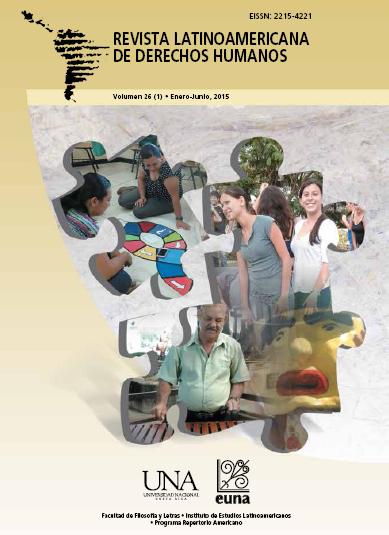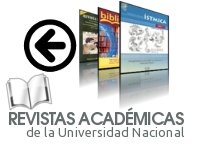LOS ESTADOS UNIDOS DE AMÉRICA Y LA APROPIACIÓN DEL TERRITORIO INDÍGENA
DOI:
https://doi.org/10.15359/rldh.26-1.10Palavras-chave:
Shoshón Occidental, Mary y Carrie Dann, Declaración Americana, Estados Unidos de América, Giorgio Agamben.Resumo
Este artículo examina la relación que existe entre la democracia con los pueblos indígenas apartir del concepto Homo sacer (Homines sacri), acuñado por Giorgio Agamben (1998). El argumentocentral es que actos cometidos contra el Indio Americano o sus propiedades (tierras yrecursos naturales) pueden ser interpretados no solo como violaciones a los derechos humanos sino como estructuras políticas permanentes de violencia y exclusión. El artículo revisa el caso de Mary y Carrie Dann, en una disputa por tierras con los EE.UU., y que la Comisión Interamericanade Derechos Humanos (CIDH) ha considerado como violatorio de la Declaración Americana de los Derechos y Deberes del Hombre (Declaración Americana). La revisión del caso se basa en el reporte de la CIDH (2002).
Palabras clave: Shoshón Occidental, Mary y Carrie Dann, Declaración Americana, EstadosUnidos de América, Giorgio Agamben.
Abstract:
This article examines the relationship between Democracy and Indigenous Peoples from the perspective of theconcept Homo Sacer (Homines Sacri) coined by Giorgio Agamben (1998). The central argument is that acts of power committed against their rights and properties (lands and natural resources) can be interpreted not only as human rights violations but also as permanent political structures of violence and exclusion. This document reviews the case of Mary and Carrie Dann in a land dispute with the U.S. that the Inter- American Commissionof Human Rights (IACHR) has regarded as a violation of the American Declaration of the Rights and Duties of Man (American Declaration). The revision of the case is based on the IACHR´s report of 2002.
Keywords: Western Shoshone, Mary and Carrie Dann, American Declaration, United States of America, Giorgio Agamben.
Referências
Agamben, G. (1998). Homo sacer: Sovereign Power and Bare Life. EE.UU.: Stanford University Press. Recuperado de www.thing.net/~rdom/ucsd/biopolitics/HomoSacer.pdf
Anaya, J. (2012). Informe del Relator Especial sobre los derechos de los pueblos indígenas, James Anaya. Ginebra. A/HRC/21/47. Consejo de Derechos Humanos, Naciones Unidas.
______ . (2012a). Report of the Special Rapporteur on the rights of indigenous peoples, James Anaya, on the situation of indigenous peoples in the United States of America. Addendum 1. The situation of indigenous peoples in the United States of America. 30 August. Ginebra. A/HRC/21/47/Add.1. Human Rights Council, United Nations. Recuperado de http://www.ohchr.org/Documents/HRBodies/HRCouncil/RegularSession/Session21/A-HRC-21-47-Add1_en.pdf
_______. (2012b). The Significance of the Declaration On The Rights Of Indigenous Peoples.
A Conference and Consultation with the United Nations Special Rapporteur on the Rights of Indigenous Peoples, James Anaya. Tucson, Arizona on 26 and 27 April 2012. 26 de abril, Arizona, EE.UU.
_______. (2005). Indigenous Peoples´ Participatory Rights in Relation to Decisions about Natural Resource Extraction: The More Fundamental Issue of What Rights Indigenous Peoples Have in Lands and Resources. Arizona Journal of International & Comparative Law. 22(1): 7-17.
_______. (1996). Indigenous Peoples in International Law. Oxford: Oxford University Press.
_______. (2005). La legalización de los usos y costumbres electorales en Oaxaca: implicaciones éticas de una política de reconocimiento. Cuadernos del Sur, 11(21), pp. 11-22. Recuperado de http://pacificosur.ciesas.edu.mx/Images/cds/cds21.pdf
Baronnet, B., Mora, M. y Stahler-Sholk, R. (coords.) (2011). Luchas “muy otras”. Zapatismo y autonomía en las comunidades indígenas de Chiapas. México, UAM, CIESAS, UACh. Recuperado de http://zapatismoyautonomia.files.wordpress.com/2013/12/luchas-muy-otras-2011.pdf
Bureau of Indian Affairs (BIA) (2014). Western Shoshone Claims Distribution Progress Updates. U.S. Department of the Interior. Indian Affairs.
Bradford, W. (2005). Beyond Reparations: an American Indian Theory of Justice. Ohio State Law Journal, 66(1), 1-104.
Champagne, D. (2008). From first nations to self-government-A political legacy of indigenous nations in the United States. American Behavioral Scientist, 51(12), 1672-1693. http://dx.doi.org/10.1177/0002764208318925
Comisión Interamericana de Derechos Humanos (CIDH). (2002). Informe No. 75/02, Caso 11.140, Mary y Carrie Dann (Estados Unidos), 27 de diciembre de 2002. EE.UU.: CIDH. Recuperado de www.cidh.org/annualrep/2002eng/USA.11140.htm
Comisión Interamericana de Derechos Humanos (CIDH). (1999). Informe N.º 99/99, Caso 11.140, Mary y Carrie Dann (Estados Unidos), 27 de septiembre de 1999. EE.UU.: CIDH.
Recuperado de www.cidh.oas.org/annualrep/99eng/Admissible/U.S.11140.htm
Cornell, S. (2006). Indigenous Peoples, Poverty and Self-Determination in Australia, New Zealand, Canada and the United States. EE.UU.: University of Arizona y Harvard University. Recuperado de http://www.iidh.ed.cr/comunidades/diversidades/docs/div_enlinea/pobreza%20y%20autodeterminacion%20pi.pdf
Cox, K. (1998). Spaces of engagement, spaces of dependence and the politics of scale, or: looking for local politics, Political Geography. 17(1), 1–23. http://dx.doi.org/10.1016/S0962-6298(97)00048-6
Diken, B. (2004). From refugee camps to gated communities: biopolitics and the end of the city, Citizenship Studies. 8(1), 83-106. http://dx.doi.org/10.1080/1362102042000178373
Executive Office of the President (EOoP) (2013) White House Tribal Nations Conference Progress Report. EE.UU., The White House. Recuperado de http://www.whitehouse.gov/sites/default/files/docs/2013_white_house_tribal_nations_conference_progress_report.pdf
Fishel, J. (2007). United States Called to Task on Indigenous Rights: The Western Shoshone Struggle and Success at the International Level. American Indian Law Review, 31(2), 619-650. http://dx.doi.org/10.2307/20070801
Fleras, A. y Elliott, J. L. (1992). The ‘Nations Within’. Aboriginal-State Relations in Canada, the Unites States, and New Zealand. Oxford University Press, Canadá.
Franco, V. (1995). Conflicto de normas en las relaciones parentales en las culturas indígenas. En Victoria Chenaut: Pueblos indígenas frente al derecho. México: CIESAS y CEMCA, pp. 125-140.
Giaccaria, P. y Minca, C. (2011). Nazi biopolitics and the dark geographies of the selva. Journal of Genocide Research, 13(1-2), 67-84. http://dx.doi.org/10.1080/14623528.2011.559114
Greenwald, G. (2014). No Place to Hide: Edward Snowden, the NSA, and the U.S. Surveillance State. EEUU: Metropolitan Book.
Gómez, M. (1993). Sobre la naturaleza del derecho indígena: reconocimientos constitucionales y legales. Alteridades, 3(6), pp. 87-100. Recuperado de http://www.redalyc.org/pdf/747/74711380012.pdf
International Work Group for Indigenous Affairs (IWGIA). (2014). The Indigenous World 2014. Copenhagen: IWGIA. Recuperado de http://www.unesco.org/library/PDF/IndigenousWorld2014.pdf
Ivision, D; Patton, P. y Sanders, W. (eds.). (2000). Political Theory and the Rights of Indigenous Peoples. New York: Cambridge University Press.
Kinnison, A. (2011). Indigenous Consent: Rethinking U.S. Consultation Policies in Light of the U.N. Declaration on the Rights of Indigenous Peoples. Arizona Law Review, 53: 1301-1332.
Kymlicka, W. (1995). Multicultural Citizenship. Oxford: Oxford University Press. Recuperado de https://books.google.ca/books?id=5ivCp2bvqckC&printsec=frontcover&dq=Kymlicka,+W.+%281995%29.+Multicultural+Citizenship.+Oxford:+Oxford+University+Press&hl=es&sa=X&ei=ZEEHVaGAGaTIsASRoYL4BA&ved=0CBwQ6AEwAA#v=onepage&q=Kymlicka%2C%20W.%20(1995).%20Multicultural%20Citizenship.%20Oxford%3A%20Oxford%20University%20Press&f=false
Lemke, T. (2011). Bio-politics. An Advanced Introduction. EE.UU: New York University Press.
López, F. (1995). Rostros y caminos de los movimientos indígenas en México. México: MC Editores.
McDonald, B. (2009). How a Nineteenth Century Indian Treaty Stopped a Twenty-First Century Megabomb. Nevada Law Journal, 9(38), pp. 749-774. Recuperado de http://scholars.law.unlv.edu/cgi/viewcontent.cgi?article=1104&context=nlj
Mager, E. (2009). Los casinos de las tribus estadunidenses: ¿un punto clave para la autodeterminación?, Norteamérica, 4(2), pp. 73-101. Recuperado de http://www.scielo.org.mx/pdf/namerica/v4n2/v4n2a4.pdf
Miller, D. R. (2001). Indians in the United States and Canada: A comparative History (Review), Ethnohistory, 48(4), pp. 732-735. http://dx.doi.org/10.1215/00141801-48-4-732
Nagel, J. (1995). American Indian Ethnic Renewal: Politics and the Resurgence of Identity, American Sociological Review, 60(6), pp. 947-965. http://dx.doi.org/10.2307/2096434
_______. (1997). American Indian Ethnic Renewal: Red Power and the Resurgence of Identity and Culture. EE.UU.: Oxford University Press.
Nichols. R. (1998). Indians in the United States and Canada: A Comparative History. EE.UU.: University of Nebraska Press.
Obama, B. (2014). Op-Ed by President Obama in Indian Country Today. 5 de junio. The White House, Office of the Press Secretary. EE.UU. Recuperado de www.whitehouse.gov/the-press-office/2014/06/05/op-ed-president-obama-indian-country-today.
_______. (2014a). Remarks by the President at the Cannon Ball Flag Day Celebration. Standing Rock Indian Reservation Cannon Ball, North Dakota. 13 junio. The White House, Office of the Press Secretary. Recuperado de http://www.whitehouse.gov/the-press-office/2014/06/13/remarks-president-cannon-ball-flag-day-celebration
_________. (2010). Remarks by the President at the White House Tribal Nations Conference. 16 Diciembre. The White House, Office of the Press Secretary. Recuperado de www.whitehouse.gov/the-press-office/2010/12/16/remarks-president-white-house-tribal-nations-conference
Ortega, B. (2008). Biopolítica de la tortura: guantanamizar Irak. Revista Opera, (8): 7-56. Recuperado de http://www.redalyc.org/pdf/675/67500802.pdf
Patton, P. (2005). National Autonomy and Indigenous Sovereignty. En Nimni, E. (Ed). National Cultural Autonomy and its Contemporary Critics (pp. 112-123). Reino Unido: Routledge.
Rubio, M. (2007). Usos y costumbres de la comunidad indígena a la luz del derecho positivo mexicano. Revista del Instituto de la Judicatura Federal, (24), 159-178. Recuperado de http://www.ijf.cjf.gob.mx/publicaciones/revista/24/r24_6.pdf
Schinkel, W. (2009). “Illegal Aliens” and the State, or: Bare Bodies vs the Zombie. International Sociology, 24(6): 779-806. http://dx.doi.org/10.1177/0268580909343494
Sierra, T. (2004). Haciendo justicia. Interlegalidad, derecho y género en regiones indígenas. H. Cámara de Diputados, LIX Legislatura. México.
Smith, S. (2008). Hemp for Sovereignty: Scale, Territory and the Struggle for Native American sovereignty. Space and Polity, 12 (2), 231-249. http://dx.doi.org/10.1080/13562570802173364
Speed, S. (2007). Rights in Rebellion Indigenous Struggle and Human Rights in Chiapas. EE.UU.: Standford University Press.
Strickland, R. (1986). Genocide-at-Law: An Historic and Contemporary View of the Native American Experience. 34 Kansas Law Review, 713-718.
The Guardian (2013). The NSA Files. Recuperado de www.theguardian.com/world/the-nsa-files
Thiele, R. (2014). The President and First Lady's Historic Visit to Indian Country. Associate Director in the White House Office of Intergovernmental Affairs. EE.UU: White House.
Recuperado de www.whitehouse.gov/blog/2014/06/20/president-and-first-ladys-historic-visit-indian-country
Tittemore, B. (2007). The Dann Litigation and Intenational Human Rights Law: The Proceedings and Decision of the Inter-American Commission on Human Rights. American Indian Law Review, 593-605.
Trigger, B. (1985). Natives and newcomers. Canada’s “Heroic Age” Reconsidered. Canadá: McGill-Queen’s University Press.
United Nations Human Rights. Office of the High Commissioner for Human Rights (UNHR). (2012). Declaration on the rights of indigenous peoples.
United Nations Human Rights. Office of the High Commissioner for Human Rights (UNHRa). (2012). First mission to the USA by the UN Special Rapporteur on indigenous peoples. Press Release 20 April 2012. Recuperado de www.ohchr.org/EN/NewsEvents/Pages/DisplayNews.aspx?NewsID=12072&LangID=E
United Nations Special Rapporteur on the Rights of Indigenous Peoples (UNSR). (2012). Statement of the United Nations Special Rapporteur on the Rights of Indigenous Peoples, James Anaya, upon conclusion of his visit to the United States. 4 may 2012. Recuperado de
www.ohchr.org/EN/NewsEvents/Pages/DisplayNews.aspx?NewsID=12114&LangID=E
U.S. Department of State (USDoS). (2010). Announcement of U.S. Support for the United Nations Declaration on the Rights of Indigenous Peoples. Initiatives to Promote the Government-to-Government Relationship & Improve the Lives of Indigenous Peoples EE.UU. Recuperado de www.state.gov/s/tribalconsultation/declaration
Wilkins, D. y Tsianina Lomawaima, K. (2001). Uneven Ground: American Indian Sovereignty and Federal Law. EE.UU.: University of Oklahoma Press.
Downloads
Publicado
Como Citar
Edição
Seção
Licença
El material que se publica en esta Revista está bajo una licencia “Creative Commons” 3.0 Costa Rica (CC, Reconocimiento-NoComercial-SinObraDerivada 3.0 Costa Rica (CC BY-NC-ND 3.0 CR) . Esto significa que el material publicado en la revista se puede compartir (copiar y distribuir) en cualquier medio o formato considerando que se debe reconocer de forma adecuada la autoría del material y la fuente, no puede utilizarse con fines comerciales y no se aceptan las obras derivadas (remezclar, transformar o crear a partir del material).








